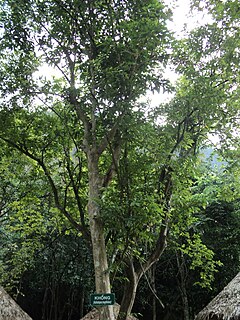Gonystylus is a southeast Asian genus of about 30 species of hardwood trees also known as ramin, melawis (Malay) and ramin telur (Sarawak).

Macaranga is a large genus of Old World tropical trees of the family Euphorbiaceae and the only genus in the subtribe Macaranginae. Native to Africa, Australasia, Asia and various islands of the Indian and Pacific Oceans, the genus comprises over 300 different species. It was first described as a genus in 1806, based on specimens collected on the Island of Mauritius.
Paracroton is a genus of flowering plants in the Euphorbiaceae first described as a genus in 1859. It is native to South and Southeast Asia, as well as New Guinea.
- Paracroton integrifolius(Airy Shaw) N.P.Balakr. & Chakr. - Kerala, Tamil Nadu
- Paracroton pendulus(Hassk.) Miq. - India, Sri Lanka, Myanmar, Thailand, Malaysia, Borneo, Sumatra, Philippines
- Paracroton sterrhopodus(Airy Shaw) Radcl.-Sm. & Govaerts - W New Guinea
- Paracroton zeylanicus(Müll.Arg.) N.P.Balakr. & Chakr. - Sri Lanka
Sampantaea amentiflora is a plant species of the family Euphorbiaceae, first described as a genus in 1972. The genus Sampantaea is monotypic and found in Thailand and Cambodia.
Spathiostemon is a genus of trees in the Euphorbiaceae family. It is native to the Bismarck Archipelago, New Guinea, Wallacea and Southeast Asia. The trees grow between 10 and 20m tall, often in secondary forest. The wood is sometimes used.
Rockinghamia is a plant genus of the spurge family (Euphorbiaceae), first described as a genus in 1966. The entire genus is endemic to the State of Queensland in Australia.
- Rockinghamia angustifolia(Benth.) Airy Shaw
- Rockinghamia brevipesAiry Shaw
Cleidiocarpon is a genus of plant of the family Euphorbiaceae first described as a genus in 1965. It is native to China and Indochina.
- Cleidiocarpon cavaleriei(H.Lév.) Airy Shaw - Yunnan, Guizhou, Guangxi, Vietnam
- Cleidiocarpon laurinumAiry Shaw - Thailand, Myanmar

Koilodepas is a genus of plant of the family Euphorbiaceae first described as a genus in 1856. It is native to Southeast Asia, India, Hainan, and New Guinea.
Cephalomappa is a genus of plant of the family Euphorbiaceae first described as a genus in 1874. It is native to Malaysia, Borneo, and Sumatra.
- Cephalomappa beccarianaBaill. - Sarawak
- Cephalomappa lepidotulaAiry Shaw - Malaysia, Borneo, Sumatra
- Cephalomappa malloticarpaJ.J.Sm. - Malaysia, Borneo, Sumatra
- Cephalomappa paludicolaAiry Shaw - Sarawak
- Cephalomappa penangensisRidl. - Peninsular Malaysia
Kairothamnus is a genus of plants under the family Picrodendraceae described as a genus in 1980. The only known species is Kairothamnus phyllanthoides, endemic to Morobe Province in Papua New Guinea.
Hylandia is a genus of plants, of the family Euphorbiaceae, named in honour of Australian botanist Bernie Hyland, by Herbert K. Airy Shaw.
Dissiliaria is a genus of plants under the family Picrodendraceae described as a genus in 1867.
Whyanbeelia is a genus of plants under the family Picrodendraceae described as a genus in 1976.
Stachyandra is a plant genus in the family Picrodendraceae first described as a genus in 1990.
Ashtonia is a genus of flowering plant belonging to the family Phyllanthaceae first described as a genus in 1968. It is native to the Malay Peninsula and Borneo.
- Ashtonia excelsa Airy Shaw - Borneo
- Ashtonia praeterita Airy Shaw - S Thailand, W Malaysia
Chorisandrachne is a genus of plants in the flowering plant family Phyllanthaceae first described as a genus in 1969. It contains only one known species, Chorisandrachne diplosperma, native to southern Thailand.

Actephila is a genus of plants in the family Phyllanthaceae, first described as a genus in 1826. It is one of 8 genera in the tribe Poranthereae, and is most closely related to Leptopus. The name of the genus is derived from two Greek words, akte, "the seashore", and philos, "loving". It refers to a coastal habitat.
Herbert Kenneth Airy Shaw was a notable English botanist and classicist.
Haplothismia is a genus of myco-heterotrophic plants in family Burmanniaceae, first described as a genus in 1952. There is only one known species, Haplothismia exannulata, endemic to southern India. The plant is mycotrophic, i.e. lacking chlorophyll and obtaining sustenance from fungi in the soil.
Choriceras is a genus of plants in the family Picrodendraceae first described as a genus in 1874.


